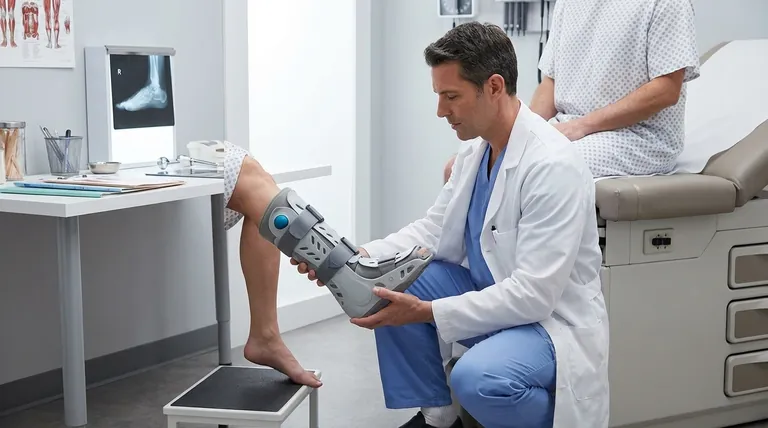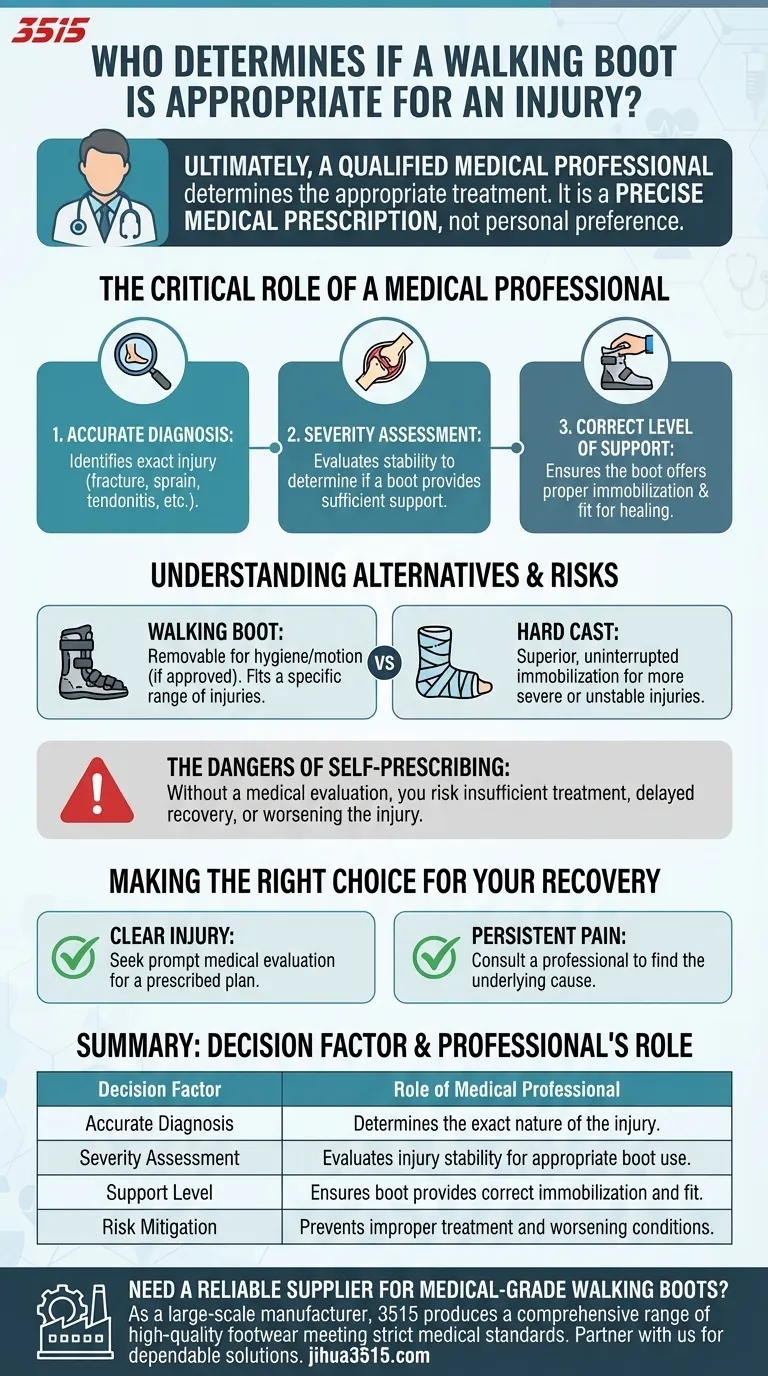Ultimately, a qualified medical professional determines if a walking boot is the appropriate treatment for an injury. A podiatrist or other doctor must perform a full examination to assess the injury's nature and severity, ensuring the boot provides the correct level of immobilization and support required for proper healing.
The decision to use a walking boot is not a matter of personal preference; it is a precise medical prescription based on a professional diagnosis. Choosing the wrong treatment can delay recovery or even worsen the injury.

The Critical Role of a Medical Professional
A walking boot, often called a CAM (controlled ankle motion) boot, is a specific medical device. Its use must be directed by an expert who understands the complexities of foot and ankle injuries.
Accurate Diagnosis is the First Step
Before any treatment is considered, a doctor must determine the exact nature of your injury. Pain in the foot or ankle can stem from a fracture, a severe sprain, tendonitis, or other conditions.
Each of these issues requires a different approach to healing. A walking boot is only effective for injuries that benefit from partial or full immobilization without the complete rigidity of a traditional cast.
Assessing the Injury's Severity
A medical expert evaluates the severity of the diagnosed injury. They will determine if the bone, ligament, or tendon is stable enough for the support a walking boot provides.
A minor sprain may only require rest and ice, while a complex or unstable fracture will almost certainly require a hard cast or even surgery. The walking boot fits a specific range of injuries between these extremes.
Ensuring the Correct Level of Support
The primary purpose of a walking boot is to immobilize the foot and ankle, which reduces pressure on the injured area and allows it to heal.
A professional ensures the boot is the correct type and fit for your specific injury, providing the necessary support without being too restrictive or too loose, both of which could hinder recovery.
Understanding the Alternatives and Risks
A walking boot is just one tool in a doctor's toolkit. The decision to use one is made after considering other potential treatments and the risks of choosing incorrectly.
The Boot vs. The Hard Cast
The choice between a walking boot and a traditional cast is based on your unique medical needs.
A boot offers the advantage of being removable for hygiene and gentle range-of-motion exercises, if approved by your doctor. However, a hard cast provides superior, uninterrupted immobilization that is necessary for more severe or unstable injuries.
The Dangers of Self-Prescribing
Attempting to self-diagnose and treat a foot or ankle injury with a store-bought walking boot is highly risky.
Without a proper medical evaluation, you risk choosing a treatment that is insufficient for your injury, potentially leading to improper healing, chronic pain, or long-term instability. You could also be masking a more serious underlying problem that requires immediate attention.
Making the Right Choice for Your Recovery
If you are experiencing significant foot or ankle pain or have sustained an injury, the path to a safe recovery is clear and requires professional guidance.
- If you have sustained a clear injury: Seek a prompt medical evaluation to receive an accurate diagnosis and a prescribed treatment plan.
- If you are experiencing persistent foot or ankle pain: Consult a podiatrist or physician to determine the underlying cause and whether a walking boot or another intervention is necessary.
Placing your trust in a medical expert's assessment is the single most important step toward a safe and complete recovery.
Summary Table:
| Decision Factor | Role of Medical Professional |
|---|---|
| Accurate Diagnosis | Determines the exact nature of the injury (e.g., fracture, sprain, tendonitis). |
| Severity Assessment | Evaluates injury stability to decide if a walking boot is appropriate. |
| Support Level | Ensures the boot provides correct immobilization and fit for optimal healing. |
| Risk Mitigation | Prevents improper treatment, delayed recovery, or worsened conditions. |
Need a reliable supplier for medical-grade walking boots? As a large-scale manufacturer, 3515 produces a comprehensive range of high-quality footwear for distributors, brand owners, and bulk clients. Our walking boots are designed to meet strict medical standards, ensuring durability and proper support for patient recovery. Partner with us to source dependable medical footwear that aligns with professional healthcare needs. Contact us today to discuss your requirements and explore our production capabilities!
Visual Guide

Related Products
- Safety Footwear Wholesale Manufacturer for Custom OEM/ODM Production
- Premium Grain Leather Safety Boots for Bulk Supply
- Customizable Anti-Smash Safety Boots for Wholesale & Private Label Manufacturing
- Wholesale Safety Footwear Manufacturer for Bulk & Custom OEM Orders
- Custom Wholesale Leather Safety Boots Direct Factory Manufacturing
People Also Ask
- Do snake bite boots work? Your Ultimate Guide to Effective Snake Bite Protection
- What are OSHA approved shoes? Understanding the Correct Standards for Workplace Safety
- What cultural and environmental considerations are tied to wearing shoes indoors? Balance Hygiene, Tradition, and Foot Health
- What do heavy duty boots do? Protect Your Feet in Demanding Work Environments
- What are the cultural perspectives on wearing shoes in the house? A Guide to Home Etiquette & Hygiene



















